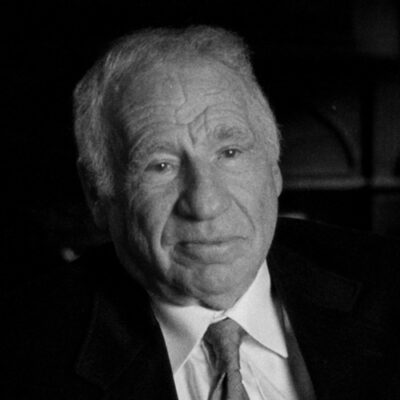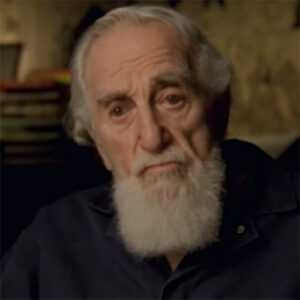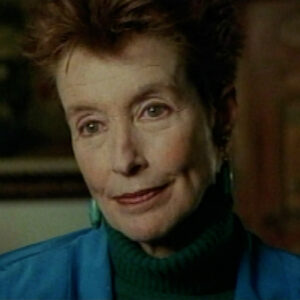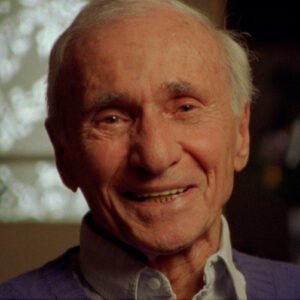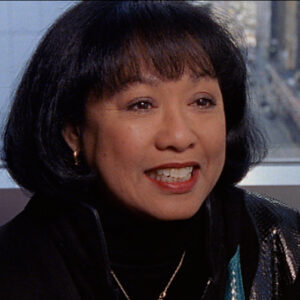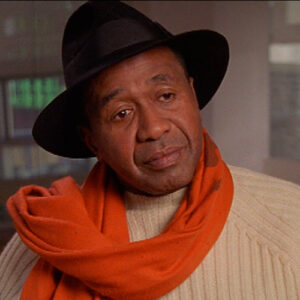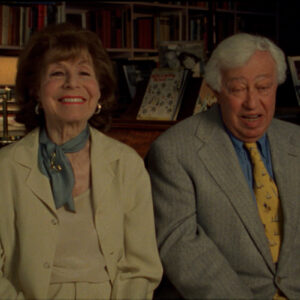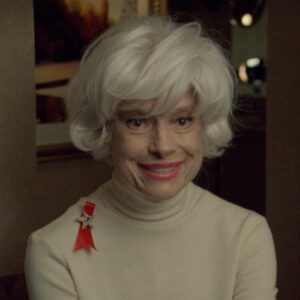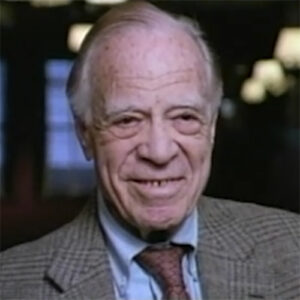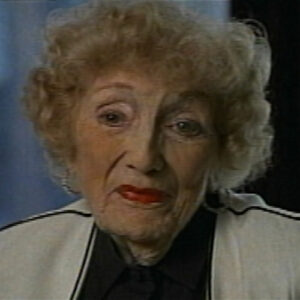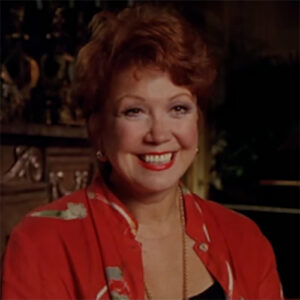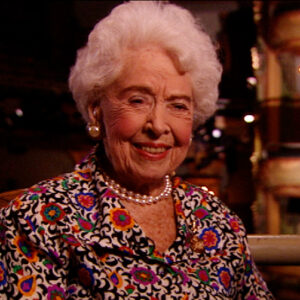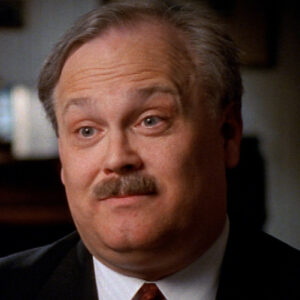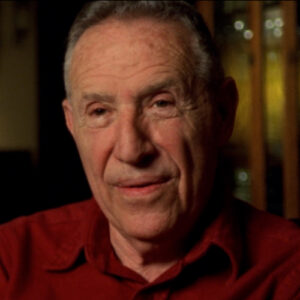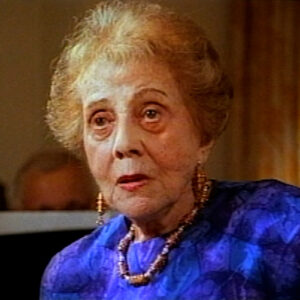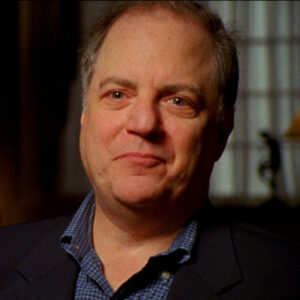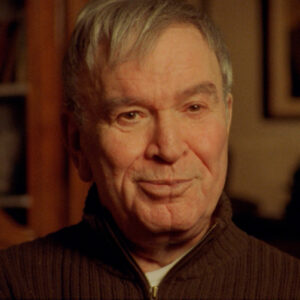Michael Kantor: Genesis for this, for the thing we know as Lion King. Just speak to that if you would, that moment where like what made you decide you wanted to do it? What moment was it like, okay, I like this, I’m gonna do it.
Julie Taymor: Well, I don’t know if it was one moment, but I really, watching the animated film, which I hadn’t seen before Tom Schumacher called me up and said, would you be interested in doing The Lion King? I looked at it and I just loved the idea of a stampede on stage. You know, the great thing about that animated film are the gigantic action sequences. And the tension between the action sequences and the very individual caricatures, characters that are presented. Is a great challenge, and I like that. I like the idea of trying to get the humanity in the animal form, and then also these epic, giant landscapes in a proscenium stage. So those are the things that drew me to it. And then the notion that we could expand on Lebo Am’s contribution. He’s the South African composer. He did all the background choral music to the movie. And one of my very first ideas that I put forth to Disney was What if that becomes the foreground music? And not only Elton writes new music, but also Lebo. The score of the animated film is by Hans Zimmer. The songs, the five songs, were by Elton John and Tim Rice, only five. And the choral contribution to the score music was by Lebo M, the South African composer. So when you go to make a musical, five songs will not suffice. And I knew that we needed another 10 or 15 songs. And I… I came up with the notion, and they were very, very happy with this notion, of bringing the South African component to the forefront, that it wouldn’t be background choral music, that it would actually, the major choral numbers and the sound and some of the principal songs and principal singer songs would be done by Lebo himself. So it’s really, it’s a very collaborative musical in the sense that Elton wrote, I think, three new songs, so altogether there are eight, and then there are seven by other people.
Michael Kantor: You know, when you sit bringing a stampede to the stage and vistas, normally I think people would go, well, that’s stuff you can’t do on stage.
Julie Taymor: That’s what I like. That’s exactly what I liked to do. I did the Haggadah at the public theater, the 10 plagues, you know, the exodus of the Jews from Egypt. That’s kind of, I enjoy that. That’s why I love Shakespeare, because Shakespeare also wrote gigantic action-filled dramas that also had some obvious romance and philosophical depth to them. But I think that is what makes theater so exciting. When you come to a stage, And you know you’re not going to see a stampede of 150 wildebeests on the stage. How does the artist create that? What is the illusion, the theatrical illusion? And the audience is there to suspend their disbelief. That’s the very important beautiful part of theater as opposed to film. Film you have to make it believable. Theater you don’t. You can be suggestive. So when you come and you suggest a canyon by Richard Hudson’s extraordinary forced perspective walls that create that depth, that force perspective depth. And then we use a barrel that has little, like almost one of those in Carnival. What are those games that you play where you’re knocking down the bull’s eye? You know what I’m talking about. Yeah, ducks. Well, I wanted that old fashioned barrel with the little wildebeest turning. And then as you get closer to the audience, they get bigger and bigger, but you don’t need the full fleshed out animal for the audience to be there with you. And that is, for me, the biggest joy of creating theater, is how do you abstract the essence of an idea, a landscape, an emotion, and put it out in a suggestive way and let the audience fill in the blanks. When they see white streamers coming out of the masks, the eyes of the lioness masks, a three-year-old knows that’s tears. And that’s very important to me, is that the audience is not spoon-fed absolute reality, but they come. And they finish the sentences with you.
Michael Kantor: What was it about the story? People can say, well, the story of Lion King is not very.
Julie Taymor: Yeah, it is.
Michael Kantor: But what was it about this story? Well, no, I just, I can’t.
Julie Taymor: Well, no, I hear it. It’s like six years now. It’s as deep as any mythic story. Now, what does that mean? This story, its very essence is about leaving your family, your tribe, your community, learning that you have a responsibility to that community, even though you’ve gone through this dark experience outside, and coming home again. That’s classic. That’s not trivial. That’s the… That’s one of those classic stories of the prodigal son. They can say Hamlet all they want, but the major essence of Lion King to me is the proddigal son story. And the reason it speaks to so many people is because that is fundamental to being human. So if you’re in Japan, you get it. If you’re an Africa, you’ll get it, now we’re going to Australia, they’ll get. Because that is part of living. It’s the accoutrement and how you tell the story is what makes it enjoyable, but the essence of a myth is something that we know deep in our bones. And we must tell it over and over again to remind us of what has gone on before and how we are to be with each other now. So I don’t think it’s small.
Michael Kantor: What do you think, you know, within the Broadway spectrum, what was unusual about it?
Julie Taymor: Well, the theatrical techniques are such an array of inspirations from Asia, Africa, traditional ancient techniques of mask and puppet work that have been reinvented and recreated in a new way. It has some vaudeville. It has old schmaltzy theater stuff from Broadway, old Broadway, and Timon and Pumba who are Borscht Belt comedians. But what makes it really unusual is that… It is a landscape that people don’t think can be put on a stage. It’s the animal kingdom, and yet we don’t hide the animals, and what I’ve often referred to as a double event is something that is very rarely done on the stage in the West. It’s done in the East a lot, which is you’re aware of the performer, the puppeteer, and you see the puppet as in Timon, and you forget about the puppeter, and your living through the puppet. You believe in the character that he’s manipulating, but we don’t try and hide the puppeteer. He is a performer too. So it’s the ability, giving the audience the opportunity, not trying to patronize them, oh, they won’t be able to focus, you know. This was a question in the development of Lion King. Big question in a workshop, so can the audience look at a human face and look at the mask at the same time, where will they focus? And I’m saying that in the theater, you can expect more from your audiences. They know they’re in a theater. I mean, I think that Tom was aware that I had been doing work. In opera and theater like Juan Darien, using non-human forms in combination with humans, meaning puppetry and mask work, creating kingdoms, animal kingdoms, as in Juan. But they never, ever would have wanted me to do a theme park because that’s what they’d done on Beauty and the Beast. And this was a new regime. When I came in, it wasn’t the same people, and they wanted to go as far away from Beauty and the beast as they could, honestly. They didn’t, they didn’t want it to look like the Impala.
Michael Kantor: You spoke to the developing of the, I almost don’t want to call them costumes, the masks and costumes people are working with. I think we have a clip of Mufasa where the thing goes up. Do you feel like your inspiration for why?
Julie Taymor: That did that? Well, there were a number of things. With those characters, the masks on top of the head really do come from ancient forms. We do see that whether you’re in Indonesia or in Africa where you might see an animal mask or even Native American on top or surrounding the human face. So you get that duality. What I really didn’t want to do was to hide the actor because If you look at the animated film, Jeremy Irons’ voice as Scar has tremendous character, as does the facial expression, which is very human in this elongated lion face of Scar. So, I needed to make sure I could keep the human beings present. The difference between humans and lions is, we’re vertical, they’re horizontal. So, this idea of the mask being able to come forward was to be used during a. An aggressive mode when the lion might be, the character of Mufasa was angry or wanted to attack or when he was moving. Originally, the way it first designed it, it literally came off and was held like a shield in front of the actor. And he moved it in front him. But then Michael Curry, my co-designer of the puppets, we talked about wouldn’t it be great if we could let the actor have his hands free to take the swords, which could be then legs. These two swords become the four legs. And so he invented this incredible mechanical device that the actor can manipulate through his costume, which allows this head to come forward and be very expressive, but it allows you to go into horizontal form.
Michael Kantor: Beak a little bit more, we were talking a little about the music and the South African pop and how, you know, in today’s, for lack of a better word, multicultural universe, that can be on Broadway. That’s pretty, you think that’s popular, it’s pretty wild.
Julie Taymor: No, I think that honestly one of the problems with Broadway is it’s not doing popular music. It’s actually the music you’re hearing, musical theater songs, are not what the kids are listening to on the radio. You don’t have Eminem on Broadway at the moment. You might have had Def Jam poetry, but that wasn’t really music. And I think it’s a problem. I think one of issues is that the music is not for young people, rarely. Even even rent still was old-fashioned musical theater sounding. So I think there’s a lot of room to explore there. We’ve had rock musicals, Tommy, which were much more what is pop music now. But the fact that what you said before, the fact that music from Africa, from Latin America, from Asia can come in, can collide and grow with Western or American musical forms is very exciting, especially in a culture like ours, which is already so mixed. It’s we are we are every other nation in the world in this place here. So I think people want to hear world music, or what else would you call that? Like in Frida, the movie Frida. Elliot Goldendahl did the score, but he of course picked up on Latin American rhythms and instruments to create something that appeals way across the board, way beyond Latin American borders.
Michael Kantor: Take us to that moment, the very first moment of the show with the calling, and you know, if you can kind of reprise that same idea that people are attracted to, you know what you said, it’s not folk, it is a different kind of pop, but it’s… It’s almost like calling you to prayer or calling you.
Julie Taymor: Well, that’s literally Rafiki, the shaman of, that we, I made her into a shaman, but whatever, she’s the lieutenant for the shamen, the witch doctor of Mufasa. She calls, she’s calling the kingdom to celebrate the birth of a new, of the next king. What I think is special about that opening, because people talk about the opening all the time. That call without it being in a language that we understand is primordial. It is something archetypal that we get. It’s this extension and when you see the sunrise and it’s a bunch of silk slats of bamboo with silk on it, it’s not a projection of a sun and the audience, it’s that thing I was saying before, they get it. It’s the sun. It’s just a bunch crumpled fabric rising. And then… Doing what theater does again that film and TV can’t do which is to surround the audience. You get all the animals coming. It goes to something very ancient. It’s also very respectful of the audience because it’s not trying to hide the strings and the rods. It’s very transparent. It is out there. You see the human beings in the elephant legs. You’ll see the two humans holding the rhinoceros suspended between them with birds on their heads. And the audience goes back to something that we all did as children which is that make believe. Where you needed very little to suggest quite a lot. Children are much more capable of comprehending an abstract image than adults are. They can put a little piece of silk on a stick and make it into a bird. Probably less so now with the computers. I’ve been very vocal about, even though I love to use computers as a tool, I think that for children it’s very, very negative, because it’s too literal. It’s much better when you have to see how you mix blue and yellow to make green with the real. Tactile texture of paint than pushing a button and saying get me green, you know It’s it’s they’re they’re missing a step in between and what they’re missing also is a visceral experience. Now this is very important for the theater visceral, visceral experience that the hyenas as they move down the aisles you feel them brushing you. What we don’t want is a synthetic, clean, removed image on that stage. You need to feel sweat, vitality. That’s why live theater will never die, because the more we get into, I think, television and film going into even more and more incredible technology, there will always be a place for the human experience, because that’s going to be sexy. That’s going be the thing that people will then crave with their senses, smell, touch, feel, everything.
Michael Kantor: That’s great. What about when you came to the New Amsterdam, which we covered in a whole other way with Ziegfeld? Did you ever feel like having these animals coming through the audience? Did you feel as though… There was a, I mean, did Siegfeld ever sort of, the idea of spectacle ever hit you that this is a continuation of Broadway spectacle or?
Julie Taymor: Well, if you really examine that beautiful theater, there’s animals everywhere. And because the Greek myths and the Shakespeare plays are carved into the stairwells, into the ceilings, into the cornices. And whoever built that theater, built it at a time where theater was a temple, was a synagogue, a church. It was there as a building to be, to invoke awe and to create that experience. It’s not like going to one of these. Junkie movie theaters where you don’t even want to know what’s in the seat next to you or who’s sitting next to your what’s on the walls you know this is this is any vent I just, probably also because I was trying to do what that film does, which is to show the east, north, south, west of the directions that everything is coming. You just knew you had to use those aisles and those doorways. And I also, when Tom and Michael Eisner asked me to do this, it wasn’t clear that it was a Broadway show. Michael wanted it to be, but it could have been done in a circus tent, it could’ve been done in a planetarium, it could be done in many spaces. So the idea was still. Let’s make the space come alive. And the other major thing that I did with the music was to bring the percussionist out of the pit because to see live percussion, even if all Broadway musicals now really don’t sound live anymore, they sound loud, but they don’t sounds live. So what’s very important is to make sure the audience is seeing that that is a percussion, a gigantic drum being beat to create that hoof beats of the stampede. And. That is part of the enjoyment, is that visual and feeling the pounding on that leather.
Michael Kantor: Great. We shot those animals in the theater. So that was like, thank you. Describe the cast of Lion King. Which one? Well, the cultural, the idea of the cultural diversity. And just, do you think that kind of rich, in the same way that the score is rich and the theatrical experience is rich, the, whatever, multicultural casting is something that Broadway would do well to take up or it is being taken up? Well.
Julie Taymor: Well, this is the thing, it was a very conscious decision that the racial casting on The Lion King, the movie didn’t care about that. I mean, it didn’t necessarily have to. So, if Matthew Broderick is the voice of Simba, it’s an animated cartoon. That doesn’t mean that the black community didn’t know that a white voice was playing Simba. We were aware of this and I think that one of the very unusual and maybe best things about the Lion King is the fact that it’s… Not about race and all about race. Most shows on Broadway, if there are African-American performers, there’s going to be the subject of racism somewhere. It’s going be about being black somewhere. It’s just, whether it’s Jelly’s Last Jam, or what was the one the year, Ragtime, or Duke Ellington, or whatever it might be, it’s about race in America. Now, here you have a show that’s 90% non-white, African-American or Chinese or whatever, but non- white. It’s nothing. They’re a bunch of animals on stage. So when white audiences go to see Lion King, they don’t think about it, which is a great thing. They don’t think about it. And they get the beauty and the talent of these great performers and the music that is African based or inspired by. And yet if a black audience goes, it’s all about race. Because Imagine a young African-American child going and seeing a king who’s black. And it celebrates Africa even though it’s obviously through the eyes of me a non-African and Garth Fagan who’s Jamaican, but he’s also origins would be Africa. But we have all of our collaborators. It’s, that’s an extraordinary thing and that makes this musical very unusual because it is, it is about a future where racism won’t be an issue at all. So I’m saying race is an issue, but not racism. And I love the way it can just move from any place. But we’re very, very, very careful even in Germany about finding Africans or in Holland. In Japan was the only place where African Japanese or if there are any, I think we had some percussionists, where it was all Japanese cast. But everywhere else we’re going, we’re trying to create this mixture of races. In Australia, we have Maoris and Samoans in with the. Caucasian, Australians, and I hope Aborigines as well.
Michael Kantor: Back us up a little bit to the idea that once you had a hit on Broadway, the Broadway world opens up. Lion King is a great example, but you know, Phantom, whatever. There’s London. Just how Broadway, while it’s a New York based, 16 theaters or whatever, then you know is cultural export and just give us some of the places that Lion King now is how many shows
Julie Taymor: Well, I think the first second show was Japan. We have two shows that have been running in Japan that were rehearsed and cast in Japan for five years now, and they’re still playing strong. And I cast it, but I was doing a movie at the time, Titus, and I didn’t come back and see it until it was already up on his feet. And I have to say I wept because it was beautifully performed, But it was the… The circle that is the emblem of the Lion King, the circle of life, really was there in my going to Japan to see the Lion king. My father was there on World War II. So you think about enemies at that time, United States and Japan, then you think about this theater piece now that communicates across any division of culture, speaks absolutely as profoundly to the African, to the Japanese audience as it does to an American. And it’s not even like… Fiddler on the roof going to Japan which is culturally interesting but it’s about a foreign culture no because this is a parable it’s an animal parable of life so it’s not particularly American life it’s just life and I had been in Japan when I was in my twenties on a fellowship studying Bunraku, Awaji, the various forms of theater and then I lived in Indonesia for four years so I’m very inspired and influenced from Asian theater. The Japanese came and saw the Lion King and they were blown away because they can see the influence of Japanese theater forms but they would never do it that way. So then I go back to Japan and I see how I was inspired by them and then they bring what I’ve done back to japan and it was totally moving to me. It was very very startling and I think one of, it’s one of the great things about theater, that it can do that, that it can actually do that in a very one-on-one. Human personal level. So now we had, well, I think Toronto closed because of SARS. I think we got caught in the middle of that. We had Toronto, we have three companies in the United States, two traveling, one in New York. We have a German company, a Dutch company opening, a London company that’s been playing for four years, and a new company in Australia that I’m going in a week to begin rehearsals for that. I don’t do all the rehearsals, but I go there to get it off the ground.
Michael Kantor: Is there any, I mean, just to bring it back to Broadway for a quick second, if this show had been done somewhere beside Broadway, would it, could it do that, or is that something? To what? Go to these different places. Is that part of the Broadway? No, I’m sure it’s part of Broadway.
Julie Taymor: No, I’m sure it’s part of the Broadway. No, it could. I mean, it’s not that there aren’t shows from Europe that travel. Aren’t some of the broadway shows, didn’t they come from France first, Les Miserables?
Michael Kantor: They don’t end up playing in eight places around the world unless they’ve.
Julie Taymor: Hit Broadway? Well, Broadway is the big marketplace. So if it can make it here, isn’t there that expression in some Broadway tune? It can make anywhere? I think that Broadway is a very good measure of a cross-section of an audience, of whether it can really appeal. And then they use that in the advertising. Sure, it helps.
Michael Kantor: What about John Lahr’s, uh… Expression that Lion King is the ultimate business art. Was there any aspect of Broadway’s business and concern for whatever you imagine the audience to be when you’re making the show or is the business art not really part of it?
Julie Taymor: Not part of what I do. I’m sure that Disney, it’s a part of what they do. But on the other hand, I know in this particular case, the idea of merchandising didn’t come until after we opened, because we had that discussion. They said, well, we’re not going to do that, because it was a concern of mine. Are you going to be merchandising? And they said no until they saw the show. But there was nothing about make the animals this way so we can sell them that way. I think, of course, it is part of, you see it everywhere in Hollywood, and of course it’s part of operation. Corporate thinking of how can we then make money off of the what is it called the uh… Not just merchandise but the subsidiary uh… I don’t know yeah whatever but i think that’s a very cynical uh… Tone to think that that’s why we did it and certainly it’s not its success is not based on the little stuffed animals that you can buy afterwards I think that that… It’s a byproduct, but it wasn’t the point of doing it.
Michael Kantor: Do you think Disney with, I mean Beauty and the Beast sort of is what it is, but do you think Disney’s changed Broadway with its big shows? And do you thing having the kind of big companies, whether they’re embodied in a Tom Schumacher or not, on Broadway is a bad thing?
Julie Taymor: No, of course I don’t think it’s a bad thing, because I think Lion King was a good experience and it’s great show. That doesn’t mean they’re all going to be great, we all have different tastes, but I think there’s room for all of it. I don’t think that just because there are the big aides or big Lion Kings, that doesn’t mean that there won’t be a smaller chamber musical that will work, and that’s been proven already. There are pieces since Lion King and since Disney started the mega musicals. And I’m not even sure Ragtime wasn’t as big as anything. Ragtime was not a Disney show. It was, what’s his name? Yeah, Garth Drabinski. So we weren’t the first big show. And Beauty and the Beast wasn’t the first big Show. It was what people despised and disliked was the notion of a conglomerate taking over and creating a synthetic kind of plastic musicals that really didn’t have heart and soul. And I think that one of the reasons that I was hired and also that I were encouraged by Schumacher to do what I do was to counteract that concept. The kind of things that I’m doing, little shadow puppets moving across the screen don’t cost a lot of money. They cost a lots in here. They’re about the quality of your ideas and the quality of execution. And I never was asked to make it bigger and better and Quite the opposite. We like what you do. When you did it on a shoestring, we’ll give you the money if you need it, but don’t think that that’s what we’re after. So in some cases, there are some big, expensive gimmicks, like the mountain rising out of the floor. When we’re on tour, we don’t have that. We can’t do it. We can go into theaters and have this gigantic Pride Rock spiraling out on this extraordinary machine. We’re not going to go and destroy every theater on tour in the country. So we’ve created something that comes on stage. I don’t think the audience is missing anything by that. I like the original design better, but as far as the experience of a live musical with human beings dancing and singing, it’s got to be in the book. It’s got be in music. If it’s not, it doesn’t matter how visually beautiful it is. But I also do believe in the power of spectacle to tell story. Often people, in a very derogatory sense, critics will say, oh, it was just spectacle. Stories are told through spectacle. Stories are tell through paintings. If we look at Picasso’s Guernica, does it mean it’s shallow because there’s no script written to it? So, or if we listen to Mozart’s Requiem Mass in Latin or whatever, do we not think that there’s depth to music on its own? So, I think it’s very important that people understand that one of the great tools of a Broadway musical is storytelling through spectacle and spectacular in the The French word is the name of the whole thing. It’s called a spectacular. We now use that spectacle to be shallow, just eye candy. And I don’t think that’s true. I think that there’s as much power in the movement of a gesture as there is in a spoken word. And that’s what musicals use as their tools, is spectacle. That’s how they tell the story.
Michael Kantor: Said you know Shakespeare’s revived all the time it’s great but there’s this sense that you know Broadway’s dying because all that’s being done in revivals. How do you feel about that?
Julie Taymor: Well, if it’s a great musical, and I mean great music and a great book, why not see it again? And there’s all these new generations that never saw it. So I’m not opposed to that. It’s when they’re mediocre that you kind of go, or they don’t stand the test of time. It’s hard. And I think what makes it tricky to do a revival of a musical is that sometimes the great part of a music would have been the choreography. So what do you do? Do you throw out Robin’s choreography or do you throw out Bob Fosse’s when you’re going to do revival of Chicago or… Or what do we have recently? You know, I mean, it’s tricky. It’s how much do you want to make it something fresh and new, a reinvestigation of an old piece, or how much you want to try and recreate that great show that opened on Broadway? And that is the dilemma more, if you can find something and reinvigorate, and yet respect the greatness that was already there. I don’t really see. Dumping Bob Vasey’s choreography because that is important to a new musical or to a musical as the music and the acting. Well Leboam who had done the choral music for Hans Zimmer’s score was asked by me and by Disney if he would come in and really start composing some original songs because he is a songwriter as well. So, with Mark Mancina, who, it’s a group of people, but… There’s something where people think if there were too many composers that it means it’s all over the place. And I don’t think that’s true in The Lion King. What happened is that Elton’s voice and Elton and Tim’s voice is very good for some of the comic characters, some of characters that were more verbal. But when you, verbal in English. But, no, this isn’t exactly right because the songs that Mark and Lebo wrote and I wrote were also in English, but they’re a different sort of song. And the African style of coral. Harmonies was brought in strongly by Lebo or something like the lioness chant and dance. That is a beautiful part of the Lion King and there’s no discernible English word in there because the other notion I had was it’s great to listen to these African languages, Xhosa and Zulu and Suthu and all of the sound and be released from having to hang on every word. The opera, we don’t care if we hear it in Italian, as long as the story is clear in the visual storytelling. So that was a really fun notion that you’d introduce your audiences to a whole bunch of languages that they’d never heard before, and that they would be able to enjoy a sound and expression, sonorities. And Lebo did a great job. And my three favorite songs are Endless Night, which I wrote the lyrics, but I loved the music. So it was Lebo’s music that really inspired me, and Shadowland, and He Lives in You. There’s a great song, of course. Can You Feel the Love Tonight and the Circle of Life, which are the ones that people are most familiar with. But these new songs also brought a different kind of depth to the musical and a different soul that really did come from the South African presence. West Side Story is the greatest American musical in my book. It still is so phenomenal. And It probably broke ground in being very contemporary in its time, speaking about issues that were contemporary. Of course, it was based on Romeo and Juliet, so it had a great model, a classic star-crossed lover’s story. And what Leonard Bernstein was able to do in bringing his great talent as a symphonic composer. Blending that and colliding that with pop music from Latin America, from Puerto Rico, with jazz made a kind of score that was completely personal to Bernstein but also had rhythms that people just hadn’t had on Broadway. It’s dark, it’s funny, it is a genius score. So without patronizing and going down to a pure, easy pop level, it was one of those great, great scores. And then you have the genius of Robin’s choreography and direction. Still you’ll see in MTV, the effects of that musical or the influences, inspirations are still so potent today in its clothing, in its look, in its stylization. I think that West Side Story was the forerunner of all MTV with its style, putting people stylized dancing in the middle of streets as in the movie musical. But it’s a classic. It’s just great all around, lyrically, in every way, it’s a great…
Michael Kantor: When you were growing up, I guess outside Boston, what did the word Broadway mean to you, and do you think it’s changed to young people today?
Julie Taymor: Well, I know that I’m one of those kids who, I had a closet full of costumes and a garage where we put on plays and I’d dance around in my living room with my best friend Peter Pan and the Wizard of Oz. So I think Broadway to me was that dreamy place of theater. I don’t think you know the difference between musicals and straight plays then. So it was just fantastic. And I was in Boston Children’s Theater when I was 11, so I was always really doing theater and in theater. I think Broadway was a destination. I wasn’t necessarily going to be an actress, and I’m not, but I was acting up until I was 21, and so Broadway was always out there as probably some fantastic mythical wonderland.
Michael Kantor: And if someone, what do you think of Broadway now? Someone says, when you think.
Julie Taymor: The pits. Now, what do I think of it now? Oh, god, a difficult place for people to experiment with their wares. I think it could be much better than it is. I really do. But the marketing of it is so difficult, the cost. The unions have made it very difficult, prohibitive, to be experimental. And I do think that there is much more room for play in what people will take in. I do believe that, but I don’t see it much on Broadway. So there’s a lot of safe stuff, or what they think will be safe. It’s very hard for people to take risks when it costs $12, $14 million to do a big new musical. And yet I think there’s still the potential to do things that break ground and that people. I don’t think all of Lion King does. I mean, there’s some pretty regular stuff in Lion King. And yet there are moments. And I think the more successful moments are the ones that are not the usual ones, are the ones that are the unusual, because people have never seen it before. So what I really do think you still have to try and do is create fresh sound, fresh images, fresh experiences. You have to give people not what they want. That’s a bore. Which you have to give them as what they didn’t know they wanted. That’s a subtle difference and that’s very tricky. I’m not saying give them what they don’t want at all because that won’t work.
Michael Kantor: Did you feel, making Lion King, the pressure of however much, you know, that cost to sort of, you now, if it doesn’t make it, it’s, you that the stakes are that much higher on Broadway?
Julie Taymor: No, I didn’t have that. Blessedly, I really didn’t that kind of pressure that people would have assumed that I had. Every idea that came up, every experiment, there was an incredible sense of excitement from it. We just maybe were luckily on a track where the two sides, me coming from the avant-garde and from off-Broadway and actually I’d done all my operas in Europe and Russia and Asia. That we, this other side, this big Disney thing with the big D that people keep talking about, we seem to be going on the same track. There wasn’t a whole lot of division on it. There was right in the beginning. The very early I came up with a whole other story for Act Two that got nixed, and I understand it now. I mean, I understand, I understood it then. But what it did was, because I had so much freedom, they allowed me so much to think and come up and do whatever you want, do whatever want. They really didn’t know what they didn’t want. They didn’t no. So instead of giving me lots of limitations, they said, just go and think about the story. Everything. It wasn’t like you’re just going to direct it. You’re going to conceive the whole thing. And when that didn’t work, I knew that, I’m not going into the details of that, because it’s. I knew that I had to create the double image, the human and the animal. I was able to resolve my issues through this technique.
Michael Kantor: What do you think Broadway, be it Lion King, or Broadway over the years says about America and our sort of, either desire to show off or our cultural optimism, or does it say anything? Is it?
Julie Taymor: I don’t know, um… I think it’s a great form that is, it is an American form. So not that it’s not done in London and other countries well, but it is one of our indigenous forms. So that says something great about the idea that you can create theater that combines dance and music and storytelling, so it’s there to be lauded as a great form of entertainment. And I think that the fact that people love live entertainment. And shows that move them. And you always see those ads of people coming out. Oh, I was so touched. You know, people do love live theater, and that is good. That’s a great thing. I think if we lost that to technology, it would be a very sad, sorry state of affairs because you wouldn’t have that specialness about going out and enjoying an event with people around you.
Michael Kantor: From when you saw West Side Story, My Fair Lady, to the present, do you think it’s changed? Do you think its in the process of changing? I mean, clearly like, it’s a different kind of piece, but is Broadway, has it changed, is it changed?
Julie Taymor: Well, I think that the successful musicals beside The Lion King that we’ve seen lately, You’re in Town, and Hairspray, and the Full Monty, I suppose, I’m just trying to think of the ones, the new musicals, producers, there’s a lot of camp, there is a lot of cynicism, this is in our culture in general, that there are less musicals on serious themes. And those are harder to pull off because we think of the form as old fashioned. So unless the form is constantly reinvigorated with new forms of style, new styles and new sounds and new ways of dancing and telling the story, it’s very hard to use the old way in a serious story, if you understand. It’s easier to send it up. You’re in Town was a perfect example of that. And We can appreciate that. I think Hairspray is a wonderful, perfect musical. It’s 1950s, but still, it’s that notion that it’s easier to laugh at. I would say that’s pretty much across the board, though, culturally. I think it’s the same in movies. I think deep, serious American films about subjects is very hard to pull off in a commercial venue. We’re just doing cartoons, comic books, blockbusters, action films, and the really personal deep stories are not coming from the United States for the most part. So it’s a very big cultural thing. It might be reflected on Broadway, but it’s not only Broadway, which is suffering from that deep cynicism about telling true stories. Now there are great stories to tell, and I think that the music industry is thriving very well, the young music industry, the hip hop world. And we begin to hear rumblings of hip hop musicals coming to life, and think that’s incredibly healthy. And what would be great is. If your 19, 18, 19, 20-year-olds see themselves telling stories more and more, not just that are three minutes long, that might be an hour, an hour and a half long, that would be a very fresh and good sign. That’s the major difference. Having a story like Pygmalion made into a serious My Fair Lady written now, I don’t really see them. They’re not faring well. The Bronte sisters, they did a few of these, and they seem to be failing. Comedy, I think musical comedy won’t die, but musicals that have serious themes are harder. If you go back to the origins of theater and how shamans, the role of the shaman, who was the first actor, first psychiatrist, witch doctor, whatever, would go, would put on the mask and then animate an object, a doll or this and that. It was, it was getting the audience. Believe that this piece of wood with a few stray horse hairs on it and some beads for eyes was alive. And when the audience is ready to do that, that’s what the suspension of disbelief is. That’s when they say that expression, that I know I’m sitting here in this cushy seat and I’m surrounded by people, but I’m willing and ready to believe that I’m in the Savannah. And you are respecting me without trying to shove it down my throat with a spoon. You’ll tell me that every little thing here is real. You’re not trying to tell me these animals are real. You’re telling me this is the essence of animal. And therefore, I as the audience member am participating, that they’re participating. And people tell me all the time that they cry in the first five minutes of The Lion King. But it is absolutely that cry that Rafiki gives. It’s partially that. And it’s then watching. These giraffes on stilts, seeing that they’re human beings doing that difficult thing, having their legs lashed to wooden poles. I’m not trying to hide them. I am not trying to pretend those are real giraffe. You see the art. It’s like circus. It is what we love about circus. There is danger. They could fall. They did fall and do fall a lot, those poor guys on the giraffe sticks. And you are there at the oldest act, which is make believe that we are there as children creating something. And making believe that it is something else. And that’s what creativity is, and that’s what imagination is, and that what you want your audience to do when they come into a theater is you want them to feel engaged. They’re not engaged when they turn on the television. They’re engaged when their watching a movie. They’re, they emote, they’re tight, they are manipulated in a good way and a bad, but it’s dead, it’s already there. It’s nothing I can do here. But when you’re asking me to believe something, I’ve got to be active doing that. Therefore, it has tremendous respect. It’s a much more sophisticated medium. It’s much more poetic than the technological, than this medium because it depends upon the audience saying, I get that they’re on a train now when all they’re doing is holding or making a movement like that. It calls upon your experience, the audience’s experience to be there. And even three and four-year-olds can get that. And that’s what’s so beautiful to me about theater and why it really is. Sophisticated of performing arts.

